-
1.Relations and Functions
11-
Revision – Functions and its Types 38 minLecture1.1
-
Revision – Functions Types 17 minLecture1.2
-
Revision – Sum Related to Relations 04 minLecture1.3
-
Revision – Sums Related to Relations, Domain and Range 22 minLecture1.4
-
Cartesian Product of Sets, Relation, Domain, Range, Inverse of Relation, Types of Relations 34 minLecture1.5
-
Functions, Intervals 39 minLecture1.6
-
Domain 01 minLecture1.7
-
Problem Based on finding Domain and Range 39 minLecture1.8
-
Types of Real function 31 minLecture1.9
-
Odd & Even Function, Composition of Function 32 minLecture1.10
-
Chapter Notes – Relations and FunctionsLecture1.11
-
-
2.Inverse Trigonometric Functions
16-
Revision – Introduction, Some Identities and Some Sums 16 minLecture2.1
-
Revision – Some Sums Related to Trigonometry Identities, trigonometry Functions Table and Its Quadrants 35 minLecture2.2
-
Revision – Trigonometrical Identities-Some important relations and Its related Sums 16 minLecture2.3
-
Revision – Sums Related to Trigonometrical Identities 18 minLecture2.4
-
Revision – Some Trigonometric Identities and its related Sums 42 minLecture2.5
-
Revision – Trigonometry Equations 44 minLecture2.6
-
Revision – Sum Based on Trigonometry Equations 08 minLecture2.7
-
Introduction to Inverse Trigonometry Function, Range, Domain, Question based on Principal Value 37 minLecture2.8
-
Property -1 of Inverse trigo function 28 minLecture2.9
-
Property -2 to 4 of Inverse trigo function 48 minLecture2.10
-
Questions based on properties of Inverse trigo function 19 minLecture2.11
-
Question based on useful substitution 27 minLecture2.12
-
Numerical problems 19 minLecture2.13
-
Numerical problems 24 minLecture2.14
-
Numerical problems , introduction to Differentiation 44 minLecture2.15
-
Chapter Notes – Inverse Trigonometric FunctionsLecture2.16
-
-
3.Matrices
9-
What is matrix 26 minLecture3.1
-
Types of matrix 28 minLecture3.2
-
Operations of matrices 28 minLecture3.3
-
Multiplication of matrices 29 minLecture3.4
-
Properties of a matrices 44 minLecture3.5
-
Numerical problems 19 minLecture3.6
-
Solution of simultaneous linear equation 28 minLecture3.7
-
Solution of simultaneous / Homogenous linear equation 24 minLecture3.8
-
Chapter Notes – MatricesLecture3.9
-
-
4.Determinants
6-
Introduction of Determinants 23 minLecture4.1
-
Properties of Determinants 29 minLecture4.2
-
Numerical problems 15 minLecture4.3
-
Numerical problems 16 minLecture4.4
-
Applications of Determinants 17 minLecture4.5
-
Chapter Notes – DeterminantsLecture4.6
-
-
5.Continuity
7-
Introduction to continuity 28 minLecture5.1
-
Numerical problems 17 minLecture5.2
-
Numerical problems 22 minLecture5.3
-
Basics of continuity 26 minLecture5.4
-
Numerical problems 17 minLecture5.5
-
Numerical problems 11 minLecture5.6
-
Chapter Notes – Continuity and DifferentiabilityLecture5.7
-
-
6.Differentiation
14-
Introduction to Differentiation 27 minLecture6.1
-
Important formula’s 29 minLecture6.2
-
Numerical problems 29 minLecture6.3
-
Numerical problems 31 minLecture6.4
-
Differentiation by using trigonometric substitution 21 minLecture6.5
-
Differentiation of implicit function 21 minLecture6.6
-
Differentiation of logarthmetic function 31 minLecture6.7
-
Differentiation of log function 25 minLecture6.8
-
Infinite series & parametric function 26 minLecture6.9
-
Infinite series & parametric function 27 minLecture6.10
-
Higher order derivatives 27 minLecture6.11
-
Differentiation of function of a function 16 minLecture6.12
-
Numerical problems 27 minLecture6.13
-
Numerical problems 04 minLecture6.14
-
-
7.Mean Value Theorem
4-
Lagrange theorem 24 minLecture7.1
-
Rolle’s theorem 20 minLecture7.2
-
Lagrange theorem 24 minLecture7.3
-
Rolle’s theorem 20 minLecture7.4
-
-
8.Applications of Derivatives
6-
Rate of change of Quantities 30 minLecture8.1
-
Rate of change of Quantities 18 minLecture8.2
-
Rate of change of Quantities 18 minLecture8.3
-
Approximation 10 minLecture8.4
-
Approximation 05 minLecture8.5
-
Chapter Notes – Applications of DerivativesLecture8.6
-
-
9.Increasing and Decreasing Function
5-
Introduction 36 minLecture9.1
-
Numerical Problem 26 minLecture9.2
-
Numerical Problem 22 minLecture9.3
-
Numerical Problem 22 minLecture9.4
-
Numerical Problem 21 minLecture9.5
-
-
10.Tangents and Normal
3-
Introduction 34 minLecture10.1
-
Numerical Problems 32 minLecture10.2
-
Angle of intersection of two curves 27 minLecture10.3
-
-
11.Maxima and Minima
10-
Introduction 28 minLecture11.1
-
Local maxima & Local Minima 27 minLecture11.2
-
Numerical Problems 37 minLecture11.3
-
Maximum & minimum value in closed interval 19 minLecture11.4
-
Application of Maxima & Minima 10 minLecture11.5
-
Application of Maxima & Minima 14 minLecture11.6
-
Numerical Problems 17 minLecture11.7
-
Numerical Problems 18 minLecture11.8
-
Numerical Problems 15 minLecture11.9
-
Numerical Problems 14 minLecture11.10
-
-
12.Integrations
19-
Introduction to Indefinite Integration 37 minLecture12.1
-
Integration by substitution 25 minLecture12.2
-
Numerical problems on Substitution 39 minLecture12.3
-
Numerical problems on Substitution 04 minLecture12.4
-
Integration various types of particular function (Identities) 31 minLecture12.5
-
Integration by parts-1 18 minLecture12.6
-
Integration by parts-2 10 minLecture12.7
-
Integration by parts-2 16 minLecture12.8
-
Integration by parts-2 08 minLecture12.9
-
ILATE Rule 12 minLecture12.10
-
Integration of some special function 07 minLecture12.11
-
Integration of some special function 06 minLecture12.12
-
Integration by substitution using trigonometric 14 minLecture12.13
-
Evaluation of some specific Integration 12 minLecture12.14
-
Evaluation of some specific Integration 29 minLecture12.15
-
Integration by partial fraction 27 minLecture12.16
-
Integration of some special function 11 minLecture12.17
-
Numerical Problems based on partial fraction 20 minLecture12.18
-
Chapter Notes – IntegralsLecture12.19
-
-
13.Definite Integrals
11-
Introduction 24 minLecture13.1
-
Properties of Definite Integration 19 minLecture13.2
-
Numerical problem based on properties 22 minLecture13.3
-
Area under the curve 16 minLecture13.4
-
Area under the curve (Ellipse) 20 minLecture13.5
-
Area under the curve (Parabola) 10 minLecture13.6
-
Area under the curve (Parabola & Circle) 40 minLecture13.7
-
Area bounded by lines 10 minLecture13.8
-
Numerical problems 25 minLecture13.9
-
Area under the curve (Circle ) 02 minLecture13.10
-
Chapter Notes – Application of IntegralsLecture13.11
-
-
14.Differential Equations
6-
Introduction to chapter 38 minLecture14.1
-
Solution of D.E. – Variable separation methods 14 minLecture14.2
-
Solution of D.E. – Variable separation methods 27 minLecture14.3
-
Solution of D.E. – Second order 21 minLecture14.4
-
Homogeneous D.E. 31 minLecture14.5
-
Chapter Notes – Differential EquationsLecture14.6
-
-
15.Vectors
12-
Introduction , Basic concepts , types of vector 34 minLecture15.1
-
Position vector, distance between two points, section formula 44 minLecture15.2
-
Numerical problem 02 minLecture15.3
-
collinearity of points and coplanarity of vector 34 minLecture15.4
-
Direction cosine 18 minLecture15.5
-
Projection , Dot product, Cauchy- Schwarz inequality 24 minLecture15.6
-
Numerical problem (dot product) 20 minLecture15.7
-
Vector (Cross) product , Lagrange’s Identity 15 minLecture15.8
-
Numerical problem (cross product) 38 minLecture15.9
-
Numerical problem (cross product) 06 minLecture15.10
-
Numerical problem (cross product) 22 minLecture15.11
-
Chapter Notes – VectorsLecture15.12
-
-
16.Three Dimensional Geometry
7-
Introduction to 3D, axis in 3D, plane in 3D, Distance between two points 32 minLecture16.1
-
Numerical problems , section formula , centroid of a triangle 35 minLecture16.2
-
projection , angle between two lines 40 minLecture16.3
-
Numerical Problem based on Direction ratio & cosine 02 minLecture16.4
-
locus of any point 15 minLecture16.5
-
Numerical Problem based on locus 16 minLecture16.6
-
Chapter Notes – Three Dimensional GeometryLecture16.7
-
-
17.Direction Cosine
2-
Introduction 34 minLecture17.1
-
Angle Between two vectors 25 minLecture17.2
-
-
18.Plane
3-
Introduction to plane , general equation of a plane , normal form 31 minLecture18.1
-
Angle between two planes 30 minLecture18.2
-
Distance of a point from a plane 29 minLecture18.3
-
-
19.Straight Lines
22-
Revision – Introduction, Equation of Line, Slope or Gradient of a line 24 minLecture19.1
-
Revision – Sums Related to Finding the Slope, Angle Between two Lines 22 minLecture19.2
-
Revision – Cases for Angle B/w two Lines, Different forms of Line Equation 23 minLecture19.3
-
Revision – Sums Related Finding the Equation of Line 27 minLecture19.4
-
Revision – Sums based on Previous Concepts of Straight line 32 minLecture19.5
-
Revision – Parametric Form of a Straight Line 16 minLecture19.6
-
Revision – Sums Related to Parametric Form of a Straight Line 17 minLecture19.7
-
Revision – Sums Based on Concurrent of lines, Angle b/w Two Lines 45 minLecture19.8
-
Revision – Different condition for Angle b/w two lines 04 minLecture19.9
-
Revision – Sums Based on Angle b/w Two Lines 36 minLecture19.10
-
Revision – Equation of Straight line Passes Through a Point and Make an Angle with Another Line 09 minLecture19.11
-
Revision – Sums Based on Equation of Straight line Passes Through a Point and Make an Angle with Another Line 15 minLecture19.12
-
Revision – Sums Based on Equation of Straight line Passes Through a Point and Make an Angle with Another Line 17 minLecture19.13
-
Revision – Finding the Distance of a point from the line 35 minLecture19.14
-
Revision – Sum Based on Finding the Distance of a point from the line and B/w Two Parallel Lines 33 minLecture19.15
-
Introduction to straight line , symmetric form , Angle between the lines 27 minLecture19.16
-
Numerical Problem 18 minLecture19.17
-
Angle between two lines 32 minLecture19.18
-
Unsymmetric form of Line 26 minLecture19.19
-
Numerical problem , perpendicular distance of a point from a line 22 minLecture19.20
-
Numerical Problem 21 minLecture19.21
-
Numerical problem , Condition for a line lie on a plane 26 minLecture19.22
-
-
20.Straight Lines (Vector)
4-
Vector and Cartesian equation of a straight line 27 minLecture20.1
-
Angle between two straight line 25 minLecture20.2
-
Numerical problems 37 minLecture20.3
-
Shortest Distance between two lines 22 minLecture20.4
-
-
21.Linear Programming
5-
Introduction to L.P. 30 minLecture21.1
-
Numerical Problems 43 minLecture21.2
-
Numerical Problems 23 minLecture21.3
-
Numerical Problems 17 minLecture21.4
-
Chapter Notes – Linear ProgrammingLecture21.5
-
-
22.Probability
23-
Introduction to probability 41 minLecture22.1
-
Types of events 42 minLecture22.2
-
Numerical problems 30 minLecture22.3
-
Conditional probability 12 minLecture22.4
-
Numerical problems 09 minLecture22.5
-
Numerical problems (conditional Probability) 04 minLecture22.6
-
Numerical problems (conditional Probability) 06 minLecture22.7
-
Numerical problems (conditional Probability) 05 minLecture22.8
-
Numerical problems (conditional Probability) 06 minLecture22.9
-
Bayes’ Theorem 17 minLecture22.10
-
Numerical problem ( conditional Probability) 04 minLecture22.11
-
Numerical problem ( Baye’s Theorem) 19 minLecture22.12
-
Numerical problem ( Baye’s Theorem) 18 minLecture22.13
-
Numerical problem ( Baye’s Theorem) 10 minLecture22.14
-
Mean and Variance of a random variable 09 minLecture22.15
-
Mean and Variance of a random variable 09 minLecture22.16
-
Mean and Variance of a random variable 08 minLecture22.17
-
Mean and Variance of a discrete random variable 07 minLecture22.18
-
Numerical problem 18 minLecture22.19
-
Bernoulli’s Trials & Binomial Distribution 11 minLecture22.20
-
Numerical problem 12 minLecture22.21
-
Mean and Variance of Binomial Distribution 05 minLecture22.22
-
Chapter Notes – ProbabilityLecture22.23
-
-
23.Limits
4-
Introduction to limits 35 minLecture23.1
-
Numerical problems 27 minLecture23.2
-
Rationalization 33 minLecture23.3
-
Limits in trigonometry 29 minLecture23.4
-
-
24.Partial Fractions
4-
Introduction to partial fraction 27 minLecture24.1
-
Partial Fractions 02 29 minLecture24.2
-
Partial Fractions 03 17 minLecture24.3
-
Improper partial fraction 20 minLecture24.4
-
Chapter Notes – Relations and Functions
Let A and B be two non-empty sets, then a function f from set A to set B is a rule which associates each element of A to a unique element of B.
It is represented as f: A → B and function are also called mapping.
f : A → B is called a real function, if A and B are subsets of R.
Domain and Codomain of a Real Function
Domain and codomain of a function f is a set of all real numbers x for which f(x) is a real number. Here, set A is domain and set B is codomain.
Range of a Real Function
Range of a real function, f is a set of values f(x) which it attains on the points of its domain.
Classification of Real Functions
Real functions are generally classified under two categories algebraic functions and transcendental functions.
1. Algebraic Functions
Some algebraic functions are given below
(i) Polynomial Functions If a function y = f(x) is given by

where, a0, a1, a2,…, an are real numbers and n is any non -negative integer, then f (x) is called a polynomial function in x.
If a0 ≠ 0, then the degree of the polynomial f(x) is n. The domain of a polynomial function is the set of real number R.
e.g., y = f(x) = 3x5 – 4x2 – 2x +1
is a polynomial of degree 5.
(ii) Rational Functions If a function y = f(x) is given by f(x) = φ(x) / Ψ(x)
where, φ(x) and Ψ(x) are polynomial functions, then f(x) is called rational function in x.
(iii) Irrational Functions The algebraic functions containing one or more terms having nonintegral rational power x are called irrational functions.
e.g., y = f(x) = 2√x –3√x + 6
2. Transcendental Function
A. function, which is not algebraic, is called a transcendental function. Trigonometric, Inverse trigonometric, Exponential, Logarithmic, etc are transcendental functions.
Explicit and Implicit Functions
(i) Explicit Functions A function is said to be an explicit function, if it is expressed in the form y = f(x).
(ii) Implicit Functions A function is said to be an implicit function, if it is expressed in the form f(x, y) = C, where C is constant.
e.g., sin (x + y) – cos (x + y) = 2
Intervals of a Function
(i) The set of real numbers x, such that a ≤ x ≤ b is called a closed interval and denoted by [a, b] i.e., {x: x ∈ R, a ≤ x ≤ b}.
(ii) Set of real number x, such that a < x < b is called open interval and is denoted by (a, b) i.e., {x: x ∈ R, a < x < b}
(iii) Intervals [a,b) = {x: x ∈ R, a ≤ x ≤ b} and (a, b] = {x: x ≠ R, a < x ≤ b} are called semiopen and semi-closed intervals.
Graph of Real Functions
1. Constant Function Let c be a fixed real number.
The function that associates to each real number x, this fixed number c is called a constant function i.e., y = f{x) = c for all x ∈ R.
Domain of f{x) = R
Range of f{x) = {c}
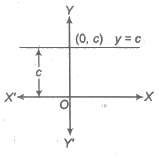
2. Identity Function
The function that associates to each real number x for the same number x, is called the identity function. i.e., y = f(x) = x, ∀ x ∈
R. Domain of f(x) = R
Range f(x) = R

3. Linear Function
If a and b be fixed real numbers, then the linear function is defmed as y = f(x) = ax + b, where a and b are constants.
Domain of f(x) = R
Range of f(x) = R
The graph of a linear function is given in the following diagram, which is a straight line with slope a.
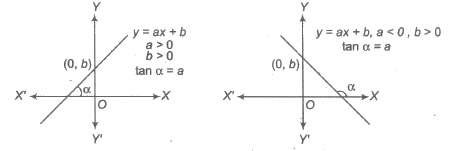
4. Quadratic Function
If a, b and c are fixed real numbers, then the quadratic function is expressed as y = f(x) = ax2 + bx + c, a ≠ 0 ⇒ y = a (x + b / 2a)2 + 4ac – b2 / 4a
which is equation of a parabola in downward, if a < 0 and upward, if a > 0 and vertex at ( – b / 2a, 4ac – b2 / 4a).
Domain of f(x) = R
Range of f(x) is [ – ∞, 4ac – b2 / 4a], if a < 0 and [4ac – b2 / 4a, ∞], if a > 0 5. Square Root Function Square root function is defined by y = F(x) = √x, x ≥ 0.

5. Square Root Function
Square root function is defined by y = F(x) = √x, x ≥ 0.
Domain of f(x) = [0, ∞)
Range of f(x) = [0, ∞)

6. Exponential Function
Exponential function is given by y = f(x) = ax, where a > 0, a ≠ 1.
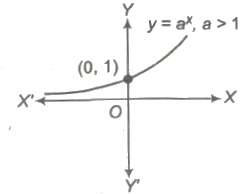
7. Logarithmic Function
A logarithmic function may be given by y = f(x) = loga x, where a > 0, a ≠ 1 and x > 0.
The graph of the function is as shown below. which is increasing, if a > 1 and decreasing, if 0 < a < 1.
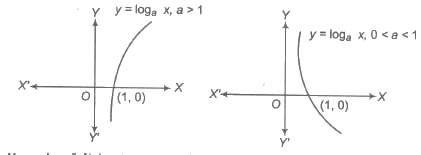
Domain of f(x) = (0, ∞)
Range of f(x) = R
8. Power Function
The power function is given by y = f(x) = xn ,n ∈ I,n≠ 1, 0. The domain and range of the graph y = f(x), is depend on n.
(a) If n is positive even integer.
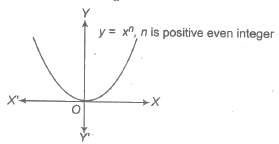
i.e., f(x) = x2, x4 ,….
Domain of f(x) = R
Range of f(x) = [0, ∞)
(b) If n is positive odd integer.

i.e., f(x) = x3, x5 ,….
Domain of f(x) = R
Range of f(x) = R
(c) If n is negative even integer.
i.e., f(x) = x– 2, x – 4 ,….
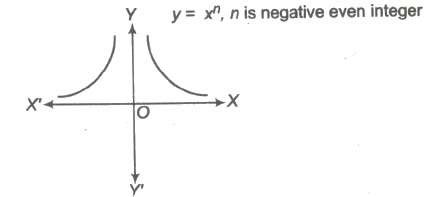
Domain of f(x) = R – {0}
Range of f(x) = (0, ∞)
(d) If n is negative odd integer.
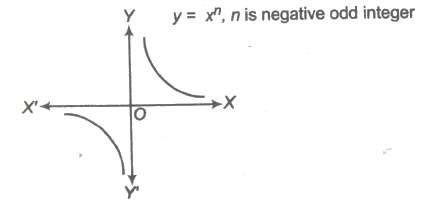
i.e., f(x) = x– 1, x – 3 ,….
Domain of f(x) = R – {0}
Range of f(x) = R – {0}
9. Modulus Function (Absolute Value Function)
Modulus function is given by y = f(x) = |x| , where |x| denotes the absolute value of x, that is
|x| = {x, if x ≥ 0, – x, if x < 0
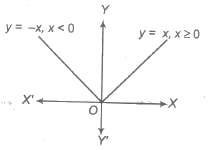
Domain of f(x) = R
Range of f(x) = [0, &infi;)

Domain of f(x) = R
Range of f(x) = {-1, 0, 1}
11. Greatest Integer Function

The greatest integer function is defined as y = f(x) = [x]
where, [x] represents the greatest integer less than or equal to x. i.e., for any integer n, [x] = n, if n ≤ x < n + 1 Domain of f(x) = R Range of f(x) = I
Properties of Greatest Integer Function
(i) [x + n] = n + [x], n ∈ I
(ii) x = [x] + {x}, {x} denotes the fractional part of x.
(iii) [- x] = – [x], -x ∈ I
(iv) [- x] = – [x] – 1, x ∈ I
(v) [x] ≥ n ⇒ x ≥ n,n ∈ I
(vi) [x] > n ⇒ x ⇒ n+1, n ∈ I
(vii) [x] ≤ n ⇒ x < n + 1, n ∈ I
(viii) [x] < n ⇒ x < n, n ∈ I
(ix) [x + y] = [x] + [y + x – [x}] for all x, y ∈ R
(x) [x + y] ≥ [x] + [y]
(xi) [x] + [x + 1 / n] + [x + 2 / n] +…+ [x + n – 1 / n] = [nx], n ∈ N
12. Least Integer Function
The least integer function which is greater than or equal to x and it is denoted by (x). Thus, (3.578) = 4, (0.87) = 1, (4) = 4, (- 8.239) = – 8, (- 0.7) = 0

In general, if n is an integer and x is any real number between n and (n + 1).
i.e., n < x ≤ n + 1, then (x) = n + 1
∴ f(x) = (x)
Domain of f = R
Range of f= [x] + 1
13. Fractional Part Function
It is denoted as f(x) = {x} and defined as
(i) {x} = f, if x = n + f, where n ∈ I and 0 ≤ f < 1
(ii) {x} = x – [x]
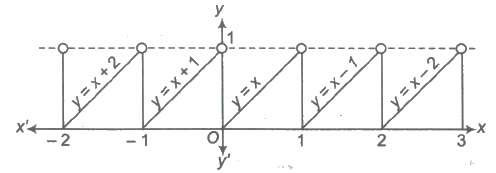
i.e., {O.7} = 0.7, {3} = 0, { – 3.6} = 0.4
(iii) {x} = x, if 0 ≤ x ≤ 1
(iv) {x} = 0, if x ∈ I
(v) { – x} = 1 – {x}, if x ≠ I
Graph of Trigonometric Functions
1. Graph of sin x
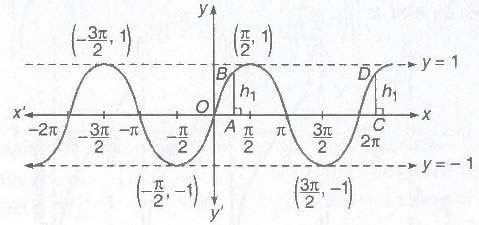
(i) Domain = R
(ii) Range = [-1,1]
(iii) Period = 2π
2. Graph of cos x
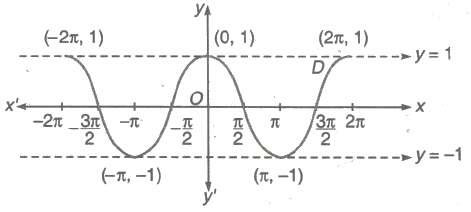
(i) Domain = R
(ii) Range = [-1,1]
(iii) Period = 2π
3.Graph of tan x
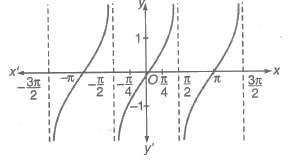
(i) Domain = R ~ (2n + 1) π / 2, n ∈ I
(ii) Range = [- &infi;, &infi;]
(iii) Period = π
4. Graph of cot x

(i) Domain = R ~ nπ, n ∈ I
(ii) Range = [- &infi;, &infi;]
(iii) Period = π
5. Graph of sec x
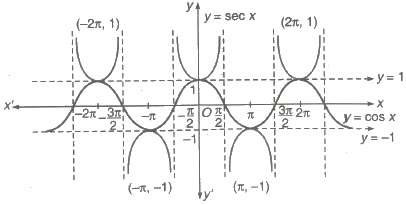
(i) Domain = R ~ (2n + 1) π / 2, n ∈ I
(ii) Range = [- &infi;, 1] ∪ [1, &infi;)
(iii) Period = 2π
6. Graph of cosec x
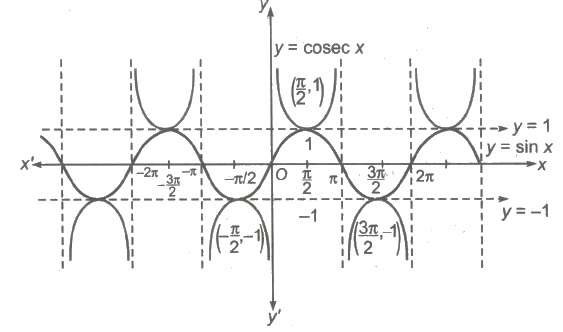
(i) Domain = R ~ nπ, n ∈ I
(ii) Range = [- &infi;, – 1] ∪ [1, &infi;)
(iii) Period = 2π
Operations on Real Functions
Let f: x → R and g : X → R be two real functions, then
(i) Sum The sum of the functions f and g is defined as f + g : X → R such that (f + g) (x) = f(x) + g(x).
(ii) Product The product of the functions f and g is defined as fg : X → R, such that (fg) (x) = f(x) g(x) Clearly, f + g and fg are defined only, if f and g have the same domain. In case, the domain of f and g are different. Then, Domain of f + g or fg = Domain of f ∩ Domain of g.
(iii) Multiplication by a Number Let f : X → R be a function and let e be a real number .
Then, we define cf: X → R, such that (cf) (x) = cf (x), ∀ x ∈ X.
(iv) Composition (Function of Function) Let f : A → B and g : B → C be two functions. We define gof : A → C, such that got (c) = g(f(x)), ∀ x ∈ A
Alternate There exists Y ∈ B, such that if f(x) = y and g(y) = z, then got (x) = z
Periodic Functions
A function f(x) is said to be a periodic function of x, provided there exists a real number T > 0, such that F(T + x) = f(x), ∀ x ∈ R
The smallest positive real number T, satisfying the above condition is known as the period or the fundamental period of f(x) ..
Testing the Periodicity of a Function
(i) Put f(T + x) = f(x) and solve this equation to find the positive values of T independent of x.
(ii) If no positive value of T independent of x is obtained, then f(x) is a non-periodic function.
(iii) If positive val~es ofT independent of x are obtained, then f(x) is a periodic function and the least positive value of T is the period of the function f(x).
Important Points to be Remembered
(i) Constant function is periodic with no fundamental period.
(ii) If f(x) is periodic with period T, then 1 / f(x) and. √f(x) are also periodic with f(x) same period T.
{iii} If f(x) is periodic with period T1 and g(x) is periodic with period T2, then f(x) + g(x) is periodic with period equal to LCM of T1 and T2, provided there is no positive k, such that f(k + x) = g(x) and g(k + x) = f(x).
(iv) If f(x) is periodic with period T, then kf (ax + b) is periodic with period T / |a|’ where a, b ,k ∈ R and a, k ≠ 0.
(v) sin x, cos x, sec x and cosec x are periodic functions with period 2π.
(vi) tan x and cot x are periodic functions with period π.
(vii) |sin x|, |cos x|, |tan x|, |cot x|, |sec x| and |cosec x| are periodic functions with period π.
(viii) sinn x, cosn x, secn x and cosecnx are periodic functions with period 2π when n is odd, or π when n is even .
(ix) tann x and cotnx are periodic functions with period π.
(x) |sin x| + |cos x|, |tan x| + |cot x| and |sec x| + |cosec x| are periodic with period π / 2.
Even and Odd Functions
Even Functions A real function f(x) is an even function, if f( -x) = f(x).
Odd Functions A real function f(x) is an odd function, if f( -x) = – f(x).
Properties of Even and Odd Functions
(i) Even function ± Even function = Even function.
(ii) Odd function ± Odd function = Odd function.
(iii) Even function * Odd function = Odd function.
(iv) Even function * Even function = Even function.
(v) Odd function * Odd function = Even function.
(vi) gof or fog is even, if anyone of f and g or both are even.
(vii) gof or fog is odd, if both of f and g are odd.
(viii) If f(x) is an even function, then d / dx f(x) or ∫ f(x) dx is odd and if dx .. f(x) is an odd function, then d / dx f(x) or ∫ f(x) dx is even.
(ix) The graph of an even function is symmetrical about Y-axis.
(x) The graph of an odd function is symmetrical about origin or symmetrical in opposite quadrants.
(xi) An even function can never be one-one, however an odd function mayor may not be oneone.
Different Types of Functions (Mappings)
1. One-One and Many-One Function
The mapping f: A → B is a called one-one function, if different elements in A have different images in B. Such a mapping is known as injective function or an injection.
Methods to Test One-One
(i) Analytically If x1, x2 ∈ A, then f(x1) = f(x2) => x1 = x2 or equivalently x1 ≠ x2 => f(x1) ≠ f(x2)
(ii) Graphically If any .line parallel to x-axis cuts the graph of the function atmost at one point, then the function is one-one.
(iii) Monotonically Any function, which is entirely increasing or decreasing in whole domain, then f(x) is one-one.
Number of One-One Functions Let f : A → B be a function, such that A and B are finite sets having m and n elements respectively, (where, n > m).
The number of one-one functions n(n – 1)(n – 2) …(n – m + 1) = { nPm, n ≥ m, 0, n < m
The function f : A → B is called many – one function, if two or more than two different elements in A have the same image in B.
2. Onto (Surjective) and Into Function
If the function f: A → B is such that each element in B (codomain) is the image of atleast one element of A, then we say that f is a function of A ‘onto’ B.
Thus, f: A → B, such that f(A) = i.e., Range = Codomain Note Every polynomial function f: R → R of degree odd is onto.
Number of Onto (surjective) Functions Let A and B are finite sets having m and n elements respectively, such that 1 ≤ n ≤ m, then number of onto (surjective) functions from A to B is nΣr = 1 (- 1)n – r nCr rm = Coefficient ofn in n! (ex – 1)r If f : A → B is such that there exists atleast one element in codomain which is not the image of
Thus, f : A → B, such that f(A) ⊂ B
i.e., Range ⊂ Codomain
Important Points to be Remembered
(i) If f and g are injective, then fog and gof are injective.
(ii) If f and g are surjective, then fog is surjective.
(iii) Iff and g are bijective, then fog is bijective.
Inverse of a Function
Let f : A → B is a bijective function, i.e., it is one-one and onto function.
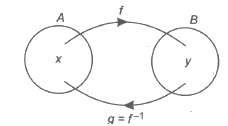
We define g : B → A, such that f(x) = y => g(y) = x, g is called inverse of f and vice-versa.
Symbolically, we write g = f-1
Thus, f(x) = y => f-1(y) = x
